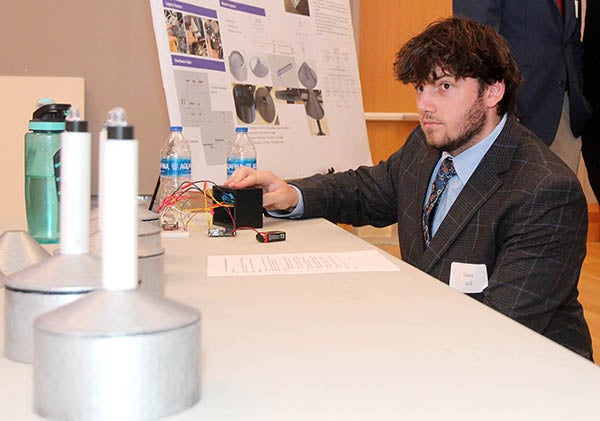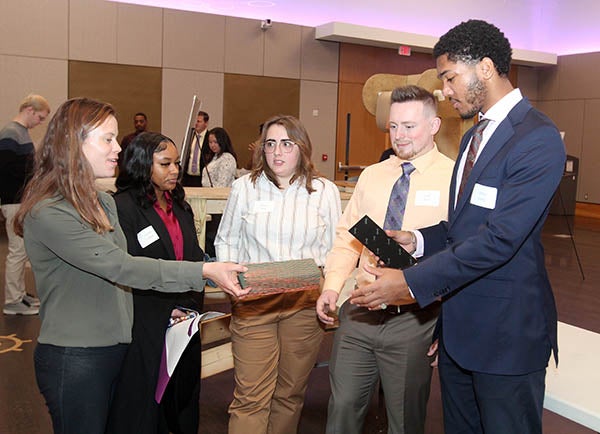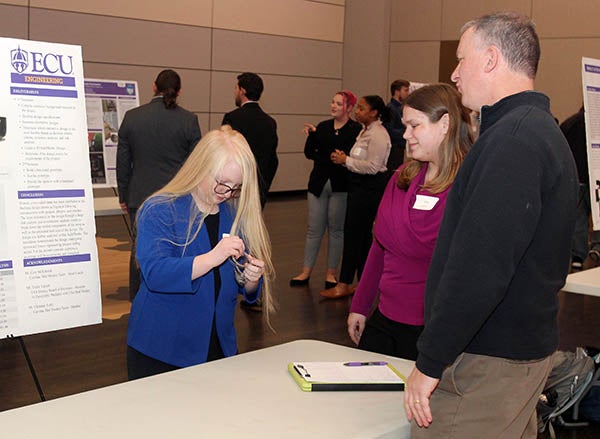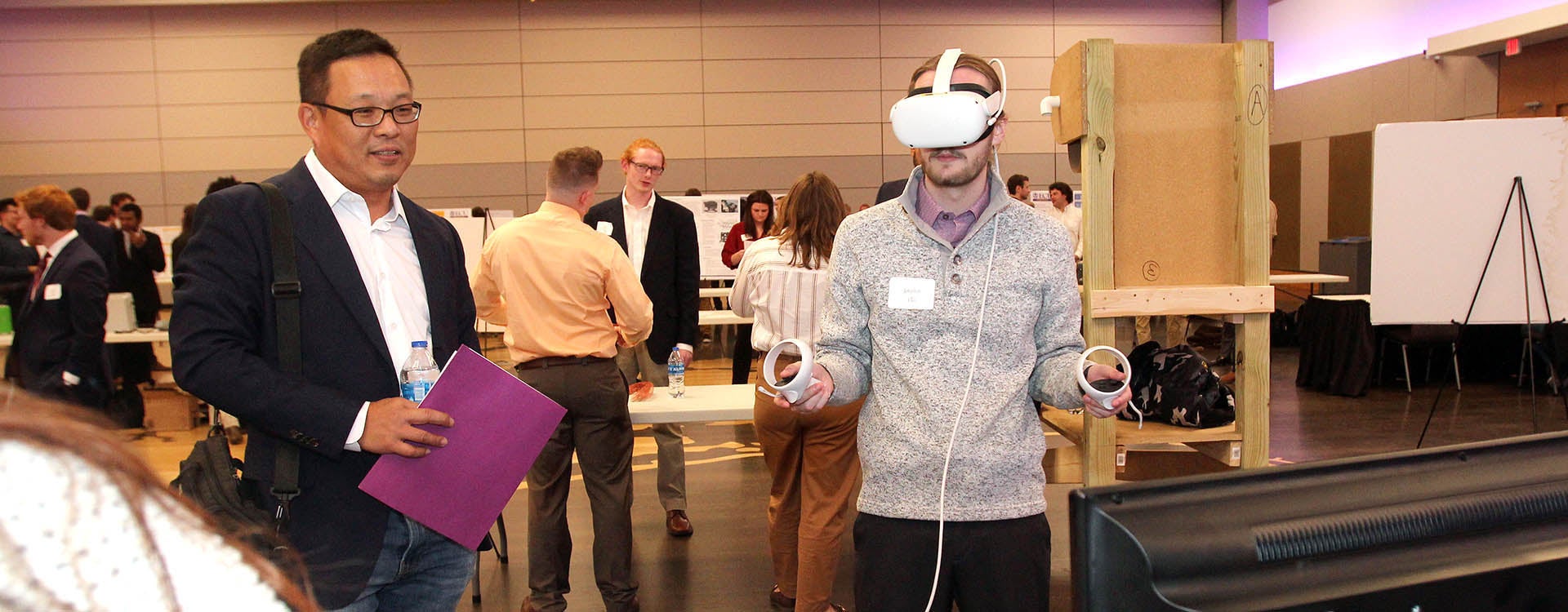ENGINEERING SOLUTIONS
ECU symposium highlights projects to fix everyday problems
The fall Department of Engineering Capstone Symposium at East Carolina University highlighted how students are helping to make the world a better and safer place in everyday life.
Spread throughout the ballrooms of the Main Campus Student Center, the symposium featured innovative projects designed to help small businesses, improve occupational safety, offer solutions to today’s technical problems and support accessibility for all athletes, among the 22 exhibits.
Safety First
Leah Beth Warren sees the importance of her senior capstone project — creating virtual reality safety training for computer numerical control (CNC) manufacturing machines.
“CNC machines can be very dangerous, and previous tutorial methods and videos don’t aid in retention,” Warren said. “This involves a lot more interaction. You put on the VR headset and learn how to use the CNC machine without actually having to touch it where it could be dangerous to you, so that by the time you operate one in real life, you’ll know the safety features and everything you need to do.”
CNC machines feature parts that move in multiple directions, which created the biggest challenge for the team.
“This project involved very intense and difficult coding. It’s very user friendly, but that made it very difficult to code it,” Warren said. “Figuring out all of those moving parts through coding was really the most difficult part. We’re engineers, not coders, but we can do it all.”
The team of Warren, Jonathan Ellis, Hannah Spier and Mitchell Staley took great pride in seeing the project come together.
“It was really fun to see it come to life,” Warren said. “We had to put on the headset to be able to test things, and getting it to work was just such great moments. Every week when we would put in a new code and it would work, we would all try it on and test it out to see it, and that was just so fun. Just to see it all come together was great.”
Warren has been working in the pharmaceutical industry for two years. Still, she said the capstone project helped her grow.
“I was the team lead, so this project really helped me with my leadership skills,” she said. “The coding really helped, just getting those computer skills, but it was definitely the team leadership.”

Engineering student Thomas Wall demonstrates an independent lighting system during the fall engineering capstone symposium.
Lighting the Way
The team of Josh Price, Tristian Wagoner, Thomas Wall and Cole Williams worked on a lighting system for induction ceremonies for the Tau Beta Pi engineering honor society. Wagoner said the current system proved cumbersome and impractical. Their solution was a wireless option with XBee radios that is easier to use, move to different locations and store when not in use.
“They’re on their own private network, using very specific frequencies and band widths that communicate with one another through the code that they have,” Wagoner said.
He said that each individual light has its own number. It essentially ignores everything, except for its specific number, and when it gets that number, it lights.
“It’s like the signal is shouted in the air, but only one can listen at a time,” Wagoner said.
He said fitting the equipment into a small light proved difficult.
“We had a really hard system and being able to put it in a compact space, that was definitely a challenge,” he said.
He said the team enjoyed the trial-and-error part of the project.
“We had several moments, where it was like ‘Oh no. It’s not working,’ but we had these tiny celebrations where the innovation just hits right,” he said. “We were able to have these eureka moments where we could understand. Those breakthroughs were just really important.”

Dr. Blair Weaver, left, teaching assistant professor in the Department of Engineering, talks to students who designed a new method for creating a bar for large floral arrangements during the fall engineering capstone symposium.
Full Bloom
Madison French, Jonathan Murray, Chase Stancil and Jacinthia Williams worked with a small business owner on a unique problem. The business creates the bases — or spray bars — that are wrapped in wire and hold together large floral arrangements for weddings or funerals. Murray said the goals were to reduce manufacturing time and use more environmentally friendly materials.
Murray said the creation of the floral bars took about 10 minutes each.
“He would get the material in bulk. He would have to cut it to size. He had to buy the mesh wire in rolls and had to cut that to size,” he said.
Since a fully automated process was not in the budget, the team located a manufacturer that would create the bars in the proper size, and they switched from hard wire to a mesh product that is biodegradable and easier to cut.
“Now it’s three simple steps, and that cut down the assembly time to around one minute per bar,” Murray said. “We changed the materials to decrease time for the assembly and manufacturing process, and then we designed and built this workstation model where he could easily assemble the spray bars, and store the materials and the finished spray bars.”
He called the project a perfect experience for the team, especially because they had to explain technical concepts and designs to someone who is more entrepreneurial and artistic.
“We had fun. We learned a lot,” Murray said.

Engineering students Sophia Hall, left, and Yelena Shelton talk with Jeff Foeller, teaching instructor in the Department of Engineering, about their sled hockey access ramp.
Breaking the Ice
Sophia Hall, Mohamad Salahaldeen, Yelena Shelton and Evan Tosto have another semester to go before completing a project designed to support sled hockey players. Sled hockey is an adaptive version of regular hockey for individuals with impairments from the waist down. They use sleds and picks to maneuver on the ice.
However, getting onto the ice in most ice-skating rinks is the problem. A raised threshold prevents easy access.
“The problem is the top of the threshold as well as the thickness of the threshold all varies,” Salahaldeen said. “With that being said, they are currently having to be lifted over the threshold onto the ice, and when you have two teams, there’s a lot of manpower involved in that, and it just wastes a lot of time. We constructed this device to help them to get on the rink and off the rink in a timely manner and to maintain their independence as well.”
They’ve completed initial designs of a ramp with adjustable stanchions for height, handrails and a center clamp that will attach to the threshold for stability.
“All of it had to meet the standard to hold up to 500 pounds, which is the player and the sled,” Tosto said. “It needed to adjust to a height of zero to six inches because every rink is different. It needed to be used anywhere, so it needed to be as lightweight as it could, around 50 pounds or so.”
An initial estimate for construction came in at $500.
“We talked to our faculty advisor and our sponsor, and they both agreed that that was a reasonable number,” Hall said. “We were pretty happy that we were able to get our cost estimate in that range.”
Their project will continue in the spring semester.
“Our plan for the future is to order the parts, build it and test the design to see if it works,” Hall said.
They plan to present their final project in the spring 2024 engineering capstone symposium in April.
Other projects exhibited during the symposium included a aircraft cargo winch, knee support and stabilizer design, dog training and exercise device and a catfish pond oxygen monitoring system, among others.
